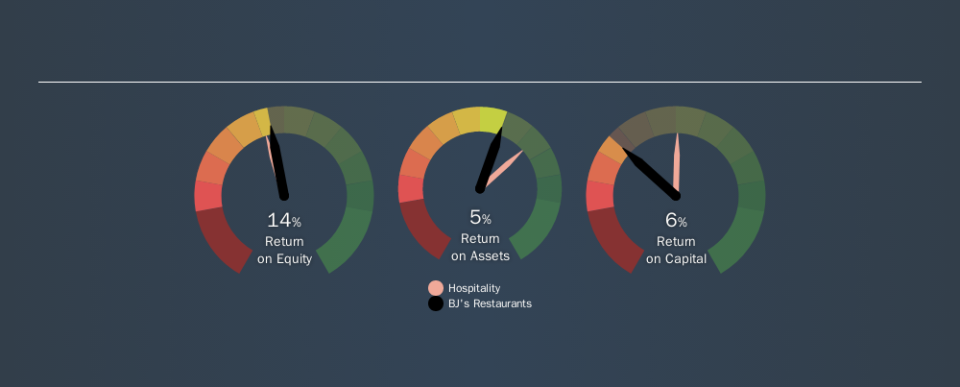How Do BJ's Restaurants, Inc.’s (NASDAQ:BJRI) Returns On Capital Compare To Peers?

Today we are going to look at BJ's Restaurants, Inc. (NASDAQ:BJRI) to see whether it might be an attractive investment prospect. To be precise, we'll consider its Return On Capital Employed (ROCE), as that will inform our view of the quality of the business.
First, we'll go over how we calculate ROCE. Then we'll compare its ROCE to similar companies. Finally, we'll look at how its current liabilities affect its ROCE.
Return On Capital Employed (ROCE): What is it?
ROCE measures the 'return' (pre-tax profit) a company generates from capital employed in its business. In general, businesses with a higher ROCE are usually better quality. In brief, it is a useful tool, but it is not without drawbacks. Author Edwin Whiting says to be careful when comparing the ROCE of different businesses, since 'No two businesses are exactly alike.'
So, How Do We Calculate ROCE?
Analysts use this formula to calculate return on capital employed:
Return on Capital Employed = Earnings Before Interest and Tax (EBIT) ÷ (Total Assets - Current Liabilities)
Or for BJ's Restaurants:
0.062 = US$56m ÷ (US$1.1b - US$156m) (Based on the trailing twelve months to July 2019.)
So, BJ's Restaurants has an ROCE of 6.2%.
View our latest analysis for BJ's Restaurants
Does BJ's Restaurants Have A Good ROCE?
When making comparisons between similar businesses, investors may find ROCE useful. We can see BJ's Restaurants's ROCE is meaningfully below the Hospitality industry average of 8.9%. This could be seen as a negative, as it suggests some competitors may be employing their capital more efficiently. Separate from how BJ's Restaurants stacks up against its industry, its ROCE in absolute terms is mediocre; relative to the returns on government bonds. It is possible that there are more rewarding investments out there.
BJ's Restaurants's current ROCE of 6.2% is lower than 3 years ago, when the company reported a 12% ROCE. Therefore we wonder if the company is facing new headwinds. The image below shows how BJ's Restaurants's ROCE compares to its industry, and you can click it to see more detail on its past growth.
It is important to remember that ROCE shows past performance, and is not necessarily predictive. ROCE can be deceptive for cyclical businesses, as returns can look incredible in boom times, and terribly low in downturns. This is because ROCE only looks at one year, instead of considering returns across a whole cycle. Future performance is what matters, and you can see analyst predictions in our free report on analyst forecasts for the company.
How BJ's Restaurants's Current Liabilities Impact Its ROCE
Liabilities, such as supplier bills and bank overdrafts, are referred to as current liabilities if they need to be paid within 12 months. Due to the way ROCE is calculated, a high level of current liabilities makes a company look as though it has less capital employed, and thus can (sometimes unfairly) boost the ROCE. To counteract this, we check if a company has high current liabilities, relative to its total assets.
BJ's Restaurants has total liabilities of US$156m and total assets of US$1.1b. Therefore its current liabilities are equivalent to approximately 15% of its total assets. It is good to see a restrained amount of current liabilities, as this limits the effect on ROCE.
Our Take On BJ's Restaurants's ROCE
That said, BJ's Restaurants's ROCE is mediocre, there may be more attractive investments around. Of course, you might find a fantastic investment by looking at a few good candidates. So take a peek at this free list of companies with modest (or no) debt, trading on a P/E below 20.
If you are like me, then you will not want to miss this free list of growing companies that insiders are buying.
We aim to bring you long-term focused research analysis driven by fundamental data. Note that our analysis may not factor in the latest price-sensitive company announcements or qualitative material.
If you spot an error that warrants correction, please contact the editor at editorial-team@simplywallst.com. This article by Simply Wall St is general in nature. It does not constitute a recommendation to buy or sell any stock, and does not take account of your objectives, or your financial situation. Simply Wall St has no position in the stocks mentioned. Thank you for reading.

 Yahoo Finance
Yahoo Finance 
